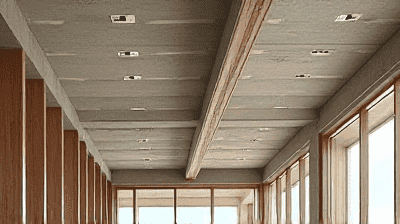
In the context of an ever-growing global population and increasing urbanization, the construction industry faces significant challenges in managing waste and environmental impact. Traditional building practices contribute to vast amounts of waste, resource depletion, and greenhouse gas emissions. However, an innovative approach known as circular construction is gaining traction. This framework emphasizes sustainability and waste reduction through the use of reusable materials, fostering a circular economy in the building sector.
Circular construction is an approach that seeks to minimize waste and maximize resource efficiency within the building industry. It diverges from the traditional linear model of "take, make, dispose" and instead promotes a circular model where resources are kept in use for as long as possible. This is achieved through practices such as reusing materials, refurbishing components, and recycling materials at the end of their life cycle.
Design for Longevity: Buildings should be designed with durability and adaptability in mind, ensuring they can serve various functions over time.
Material Selection: Choosing materials that are durable, reusable, and recyclable is crucial. This includes selecting locally-sourced materials to reduce transportation impacts.
Resource Recovery: Systems should be implemented to recover materials from deconstructed buildings, ensuring that quality reusable materials are reintegrated into the supply chain.
Waste Minimization: Efforts should focus on reducing waste throughout the construction process, from planning to execution.
Integrated Collaboration: Collaboration among architects, engineers, contractors, and stakeholders is essential to achieve cohesive circular design and construction goals.

The urgency for adopting circular construction practices arises from the multifaceted challenges that the construction industry faces, including resource scarcity, climate change, and mounting waste. Let us explore some of the key reasons why circular construction is critical.
Reduction of Waste: Circular construction minimizes waste generation by promoting the reuse and recycling of materials. This helps divert waste from landfills, reducing environmental degradation.
Lower Carbon Emissions: By utilizing existing materials instead of sourcing new ones, circular construction significantly lowers carbon emissions associated with extraction, manufacturing, and transportation.
Conservation of Resources: Circular practices help conserve finite natural resources, ensuring that they are available for future generations. This is critical in light of growing global consumption rates.
Biodiversity Protection: Sustainable material sourcing reduces the pressure on ecosystems and helps to preserve biodiversity by limiting habitat destruction.
Cost Savings: By minimizing waste and reusing materials, construction firms can significantly reduce material costs. Furthermore, using reclaimed materials often lowers disposal fees.
Job Creation: The shift toward circular construction practices can generate new employment opportunities in material recovery, refurbishment, and recycling.
Market Demand: As stakeholders prioritize sustainability, the demand for circular practices in construction is rising. Companies implementing circular construction can differentiate themselves in a competitive market.
Community Engagement: Circular construction encourages local communities to engage in decision-making and resource management, fostering a sense of ownership and responsibility towards local environments.
Improved Quality of Life: Sustainable building practices contribute to healthier indoor environments, enhancing occupant well-being and fostering community pride.
To successfully adopt circular construction principles, various strategies and practices can be employed. Below are some key approaches that the building industry can implement to reduce waste and promote the use of reusable materials.
Designing buildings for disassembly entails creating structures that can be easily taken apart at the end of their life cycle, allowing materials to be reused in new projects. Key considerations include:
Use of Mechanical Fasteners: Building components should be connected with mechanical fasteners instead of adhesives to facilitate easier disassembly.
Modular Components: Implementing modular construction techniques allows for easy reconfiguration and reuse of individual building units.
Layered Construction: Layered building systems allow different components to be removed and replaced without affecting the integrity of the entire structure.
Prioritizing the reuse and salvage of materials involves recovering valuable resources from deconstruction projects and integrating them into new builds. Effective strategies include:
Material Audits: Conducting thorough audits of existing buildings to identify reusable materials and components before demolition.
Partnerships with Salvage Centers: Collaborating with local salvage centers and deconstruction companies to facilitate the reuse of salvaged materials.
Design Workshops: Hosting workshops for architects and builders to explore innovative ways to reuse architectural elements and materials.
Utilizing recycled materials in construction not only conserves resources but also provides opportunities for innovation. Here’s how:
Sourcing Recycled Content: Use materials with recycled content, such as reclaimed wood, recycled steel, and recycled concrete aggregate.
Certification Programs: Engage with certification programs that promote the use of recycled materials and provide a framework for sustainable sourcing.
Material Innovation: Invest in research and development of new materials that incorporate recycled content while meeting performance standards.
Waste reduction practices should be integrated into every stage of construction. Effective methods include:
Lean Construction Principles: Adopt lean construction techniques that emphasize efficiency, reducing waste at every phase of the construction process.
Waste Management Plans: Develop comprehensive waste management plans that outline measures for reducing, reusing, and recycling materials on-site.
On-Site Sorting: Implement on-site sorting systems for waste materials to segregate recyclables from general construction waste.
Engaging all stakeholders in the circular construction process is essential for its success. Collaboration can be fostered through:
Education and Training: Provide training programs for construction teams that educate them on circular principles and the importance of reducing waste.
Stakeholder Workshops: Organize workshops that bring together architects, contractors, clients, and community members to brainstorm and formulate circular construction strategies.
Transparent Communication: Maintain open communication with stakeholders throughout the construction process, ensuring that everyone is aligned on circular goals.

Examining successful examples of circular construction provides valuable insights and inspiration for future projects. Below are notable case studies that illustrate innovative practices and outcomes.
The Circle is a pioneering project that embodies the principles of circular construction. This mixed-use development features an emphasis on reusing materials and minimizing waste throughout the construction process.
Material Reuse: The project extensively reused existing building components and materials from previous structures on-site, significantly reducing waste.
Collaborative Approach: Developers engaged multiple stakeholders, including suppliers and local authorities, to ensure alignment with circular principles.
The Plus Energy House is a residential project designed to produce more energy than it consumes. It showcases a unique approach to circular construction through innovative building practices.
Energy Efficiency: The house features high-performance insulation and renewable energy systems, significantly reducing its carbon footprint.
Material Innovation: Recycled and repurposed materials were utilized, including reclaimed timber and recycled concrete, to enhance sustainability.
This innovative project focuses on integrating reclaimed materials and energy solutions. It demonstrates how circular principles can be applied to public infrastructure.
Waste Recovery Systems: The building incorporates systems that reclaim wastewater for irrigation and plumbing, significantly reducing resource consumption.
Sustainable Materials: The project used a substantial amount of recycled materials in its construction, promoting resource efficiency.
The Tate Modern, a renowned art gallery housed in a former power station, exemplifies the transformation of industrial buildings using circular construction principles.
Adaptive Reuse: The project reused the original structure's materials, preserving its historical significance while modernizing its functionality.
Sustainability Initiatives: Tate Modern implemented various sustainability initiatives, including energy-efficient systems and rainwater harvesting.
Despite its benefits, circular construction faces certain challenges that may hinder its widespread adoption. These challenges include:
The construction industry is traditionally conservative, often resistant to change. Implementing circular construction practices may require overcoming skepticism from stakeholders accustomed to conventional methods.
Existing regulations may not support circular practices, creating barriers to implementation. Policymakers need to adapt regulations to promote and incentivize circular construction.
A lack of awareness and understanding of circular construction principles among contractors, architects, and clients can impede progress. Education and training are essential for fostering a culture of sustainability.
There may be challenges in sourcing high-quality reusable materials due to variations in supply and demand. Building networks for material recovery and sharing can help mitigate this issue.

The construction industry's transition to circular practices is gaining momentum, driven by increasing awareness of environmental issues and the need for sustainability. Several trends are shaping the future of circular construction:
As governments prioritize sustainability and climate action, regulatory frameworks are likely to evolve to support circular construction practices. This could include incentives for using reclaimed materials and penalties for excessive waste generation.
Technological innovations, including digital modeling and mapping tools, will enhance the efficiency of material recovery and reuse. Technologies like 3D printing may also enable the creation of new construction materials from recycled content.
Digital platforms that facilitate collaboration between stakeholders will enhance knowledge sharing and resource management. These platforms can connect contractors, architects, and material suppliers to optimize circular practices.
As consumers, businesses, and governments seek sustainable solutions, the demand for circular construction practices is expected to rise. This will drive market innovation and the development of new materials and designs.
Circular construction represents a paradigm shift in the building industry, promoting waste reduction, resource efficiency, and sustainability. By embracing the principles of circular construction and prioritizing the use of reusable materials, the industry can mitigate its environmental impact, improve economic performance, and enhance social well-being.
As stakeholders within the construction sector collaborate and innovate, circular construction will likely become an integral part of building practices in the future. By committing to circular solutions, we can create a sustainable built environment that conserves resources, protects ecosystems, and fosters resilient communities.
Embracing the circular economy in construction is not just an option but an imperative for a sustainable future. By investing in reusable materials and circular practices, we can pave the way for a greener, more sustainable built environment that benefits all.